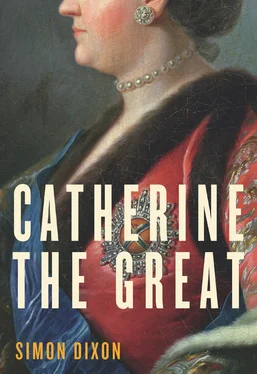Females were to be catered for by the Society for the Education of Young Noblewomen (the Smolny Institute founded in May 1764), another experiment in social engineering designed to produce nothing less than ‘a new type of mother in the form of cultured, industrious, proper young women who combined social graces with domesticity, and who would raise the general level of society through their upbringing of children’. 18Like the foundling home, the Smolny was a charitable organisation rather than a government institution, in which both Catherine and Betskoy invested personal fortunes (his, of course, being ultimately derived from hers). The empress remained devoted to the Institute for the rest of her life, taking several favourite pupils under her wing. 19
Central to the success of Catherine’s various projects were three long-serving state secretaries: Adam Olsufyev, Grigory Teplov and Ivan Yelagin. Since they and their successors probably spent more time in the empress’s company than anyone else, it was vital that each of them should know how to respond to her playful imperiousness. All three had demonstrated their loyalty to her during her difficult years as a grand duchess; all three knew how to get things done; and all three were cultivated men—precisely the sorts of educated and industrious individual that Catherine wanted to flourish in her Enlightened empire. They not only dealt with all her confidential business, but were also responsible for responding to the hundreds of petitions that flooded in despite her attempts to deter them (within a week of her coup, she had told the assembled Senate that no petitions whatsoever were to be presented to her in person). 20In return, she offered them security and material rewards, and was characteristically solicitous for their personal wellbeing.
At the age of thirty-seven, Olsufyev had been chosen in 1758 to head Elizabeth’s Closet ( Kabinet ), the personal office responsible for the distribution of imperial funds which acted as the tsars’ principal point of contact with other government bodies. Once Catherine reappointed him on 8 July 1762, he was to remain at her side until his death in 1784. As a junior member of Chancellor Bestuzhev’s staff, he had earned her lasting trust by helping her to conduct a secret correspondence with her mother in the 1750s. Now, fluent in several languages and generally acknowledged as one of the most erudite and capable men in Russia, he acted as a link between the palace, the College of Foreign Affairs and the Senate. 21
Widely supposed to be the bastard child of Peter the Great’s influential prelate, Feofan (Prokopovich), Teplov was actually the son of a smelter at the Novgorod episcopal palace, which was how he acquired his name, meaning ‘warmth’. Aged forty-six when Catherine seized the throne, he had come to prominence by supervising the education of Kirill Razumovsky, touring Europe with him for two years and managing his business when he became president of the Academy of Sciences in 1746 and Ukrainian chieftain ( hetman ) four years later. A competent violinist like Olsufyev, Teplov had translated into Russian the libretti of several operas by Francesco Araja in the 1740s and 1750s. Teplov was also a talented amateur actor who published learned articles on poetics and was familiar with radical Western writings on materialism and atheism. Having been both cuckolded and imprisoned by Peter III, he had every reason to support Catherine’s coup. It was Teplov who drafted the most important edicts in the first crucial days of her reign, when it was one of Olsufyev’s first duties to pay him a reward of 20,000 roubles. After that, he became the moving force behind numerous major projects, including the reorganisation of the Medical Chancery (one of several reforms motivated by Catherine’s determination to preserve and increase the population). He was intimately involved with Dumaresq’s abortive plans for urban primary schools, having drawn up proposals for a university at the Ukrainian town of Baturin in 1760. Probably his most important role lay in the Commission on Church Lands, created in November 1762, which was responsible two years later for a wholesale secularisation of monastic property. Since this yielded the state an annual income of almost 1.37 million roubles, of which less than 463,000 was returned to the Church each year between 1764 and 1768, it is not surprising that he remained an influential presence in Catherine’s government until his death in 1779. 22
Ivan Yelagin, the last of the three secretaries to be appointed in July 1762, was another lifelong servant who was still at her side in 1793. Four years older than the empress, he had first encountered her in 1748 as an impoverished acolyte of Elizabeth’s favourite, Aleksey Razumovsky. Ten years later, he suffered on Catherine’s behalf when he was arrested with Bestuzhev as a friend and correspondent of Stanislaw Poniatowski. Notable for his connections to English Masonic lodges, Yelagin was a leading light in Russian Freemasonry, a movement that Catherine held increasingly in contempt. On being shown one of his Masonic manuscripts after his death in 1794, she took it as evidence that her secretary had gone mad. But she always admired his loyalty. ‘This was a man of probity whom one could trust,’ the empress declared that same year. ‘Once one had gained his affection, it was not easily lost; he always demonstrated zeal and a marked liking for me.’ 23
In September 1763, Catherine decided that Teplov should report on Mondays and Wednesdays, Olsufyev on Tuesdays and Thursdays, and Yelagin on Fridays and Saturdays. 24By the time they arrived at her study at eight in the morning, she had already been up for two hours, writing and reading alone, having lit her own fire. Sketching her routine in a letter to Madame Geoffrin, she explained how a succession of secretaries and advisers trooped in one by one, keeping her busy until eleven, when she dressed for her first public appearance of the day (in the relative privacy of her own apartments Catherine wore a loose-fitting silk gown). On Sundays and feast days she attended mass in the palace chapel, after a vigil service in her rooms. Otherwise, she liked to wander into the Chevaliers Gardes’ Room, where visitors lurked in the hope of catching her eye. Lunch was a relatively modest affair, sometimes eaten alone, but usually taken in the company of between ten and twenty courtiers. Since Catherine drank little and was frugal in her culinary tastes, it was by no means an experience to savour: seasoning was limited (pepper was not sold on the capital’s markets, though it may have been supplied from the imperial greenhouses), and even some of St Petersburg’s poorest people probably ate almost as nourishing food as their empress. 25After lunch, she retreated to her own rooms, shuttling silken knots while Betskoy kept her company by reading aloud:
Our reading, when it is not interrupted by parcels of letters and other nuisances, lasts until half-past five, when I either go to the theatre, or I play, or I gossip to the first people to arrive before dinner, which is over before eleven when I retire to bed in order to do the same again on the following day. And all this is ruled out as regularly as musical manuscript paper. 26
In practice, of course, her life was more varied than this jocular summary implied. The letter studiously avoided any mention of Grigory Orlov, whom she usually entertained after lunch—an hour that gossips were to dub ‘the Time of Mystery’ for the rest of her reign. 27Paul, who lived with his Young Court in a neighbouring part of the palace, was another regular visitor to her rooms, though she rarely spent as much as half an hour with him. He saw her early on Wednesday evenings or after church on Sunday mornings—both were Court reception days when the empress entertained not only her courtiers, but also foreign visitors to the city. 28Hawking was still a favourite pastime, though Catherine’s days in the saddle were all but over, and when the weather permitted, she enjoyed a carriage ride through the streets with a favourite lady-in-waiting. These, however, were distractions from a gruelling week at her desk.
Читать дальше












